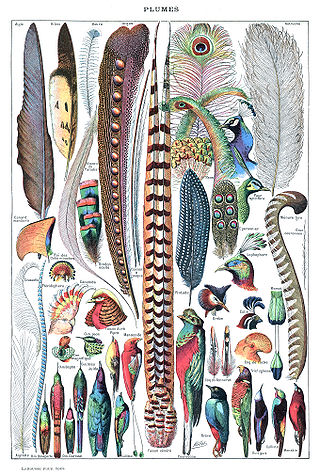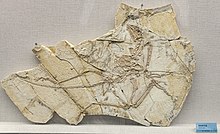
Archaeopteryx, sometimes referred to by its German name, "Urvogel" is a genus of bird-like dinosaurs. The name derives from the ancient Greek ἀρχαῖος (archaīos), meaning "ancient", and πτέρυξ (ptéryx), meaning "feather" or "wing". Between the late 19th century and the early 21st century, Archaeopteryx was generally accepted by palaeontologists and popular reference books as the oldest-known bird. Older potential avialans have since been identified, including Anchiornis, Xiaotingia, and Aurornis.

Maniraptora is a clade of coelurosaurian dinosaurs which includes the birds and the non-avian dinosaurs that were more closely related to them than to Ornithomimus velox. It contains the major subgroups Avialae, Dromaeosauridae, Troodontidae, Oviraptorosauria, and Therizinosauria. Ornitholestes and the Alvarezsauroidea are also often included. Together with the next closest sister group, the Ornithomimosauria, Maniraptora comprises the more inclusive clade Maniraptoriformes. Maniraptorans first appear in the fossil record during the Jurassic Period, and survive today as living birds.

Coelurosauria is the clade containing all theropod dinosaurs more closely related to birds than to carnosaurs.

A feathered dinosaur is any species of dinosaur possessing feathers. That includes all species of birds, and in recent decades evidence has accumulated that many non-avian dinosaur species also possessed feathers in some shape or form. The extent to which feathers or feather-like structures were present in dinosaurs as a whole is a subject of ongoing debate and research.

Scansoriopterygidae is an extinct family of climbing and gliding maniraptoran dinosaurs. Scansoriopterygids are known from five well-preserved fossils, representing four species, unearthed in the Tiaojishan Formation fossil beds of Liaoning and Hebei, China.

Archaeopterygidae is a group of paravian dinosaurs, known from the latest Jurassic and earliest Cretaceous of Europe. In most current classifications, it contains only the genera Archaeopteryx and Wellnhoferia. As its name suggests, Protarchaeopteryx was also once referred to this group, but most paleontologists now consider it an oviraptorosaur. Other referred genera, like Jurapteryx, Wellnhoferia, and "Proornis", are probably synonymous with Archaeopteryx or do not belong into this group. Jinfengopteryx was originally described as an archaeopterygid, though it was later shown to be a troodontid. A few studies have recovered Anchiornis and Xiaotingia to also be members of the Archaeopterygidae, though most subsequent analyses have failed to arrive at the same result. Uncertainties still exist, however, and it may not be possible to confidently state whether archaeopterygids are more closely related to modern birds or to deinonychosaurs barring new and better specimens of relevant species. Teeth attributable to archaeopterygids are known from the earliest Cretaceous (Berriasian) Cherves-de-Cognac locality and the Angeac-Charente bonebed of France.

The scientific question of within which larger group of animals birds evolved has traditionally been called the "origin of birds". The present scientific consensus is that birds are a group of maniraptoran theropod dinosaurs that originated during the Mesozoic Era.

Yandangornis is a genus of theropods from the Late Cretaceous Tangshang Formation of China. It lived 81.5 million years ago in what is now China. The type species, Y. longicaudus, was formally described by Cai and Zhou in 1999.

Maniraptoriformes is a clade of dinosaurs with pennaceous feathers and wings that contains ornithomimosaurs and maniraptorans. This group was named by Thomas Holtz, who defined it as "the most recent common ancestor of Ornithomimus and birds, and all descendants of that common ancestor."

Paraves are a widespread group of theropod dinosaurs that originated in the Middle Jurassic period. In addition to the extinct dromaeosaurids, troodontids, anchiornithids, and possibly the scansoriopterygids, the group also contains the avialans, which include diverse extinct taxa as well as the over 10,000 species of living birds. Basal members of Paraves are well known for the possession of an enlarged claw on the second digit of the foot, which was held off the ground when walking in some species. A number of differing scientific interpretations of the relationships between paravian taxa exist. New fossil discoveries and analyses make the classification of Paraves an active subject of research.

Avifilopluma is a clade containing all animals with feathers. Unlike most clades, which are defined based on relative relationships, Avifilopluma is defined based on an apomorphy, that is, a unique physical characteristic shared by one group and not found outside that group. Its content is unclear, and has been speculated to range from Coelurosauria to all of Ornithodira.

Epidexipteryx is a genus of small paravian dinosaurs, known from one fossil specimen in the collection of the Institute of Vertebrate Paleontology and Paleoanthropology in Beijing. Epidexipteryx represents the earliest known example of ornamental feathers in the fossil record.

Anchiornis is a genus of small, four-winged paravian dinosaurs, with only one known species, the type species Anchiornis huxleyi, named for its similarity to modern birds. The Latin name Anchiornis derives from a Greek word meaning "near bird", and huxleyi refers to Thomas Henry Huxley, a contemporary of Charles Darwin.

Xiaotingia is a genus of anchiornithid theropod dinosaur from Middle Jurassic or early Late Jurassic deposits of western Liaoning, China, containing a single species, Xiaotingia zhengi.

Eosinopteryx is an extinct genus of theropod dinosaurs known to the Late Jurassic epoch of China. It contains a single species, Eosinopteryx brevipenna.

Pennaraptora is a clade defined as the most recent common ancestor of Oviraptor philoceratops, Deinonychus antirrhopus, and Passer domesticus, and all descendants thereof, by Foth et al., 2014.

Aurornis is an extinct genus of anchiornithid theropod dinosaurs from the Jurassic period of China. The genus Aurornis contains a single known species, Aurornis xui. Aurornis xui may be the most basal ("primitive") avialan dinosaur known to date, and it is one of the earliest avialans found to date. The fossil evidence for the animal pre-dates that of Archaeopteryx lithographica, often considered the earliest bird species, by about 10 million years.

Anchiornithidae is a family of small paravian dinosaurs. Anchiornithids have been classified at varying positions in the paravian tree, with some scientists classifying them as a distinct family, a basal subfamily of Troodontidae, members of Archaeopterygidae, or an assemblage of dinosaurs that are an evolutionary grade within Avialae or Paraves.

The biogeography of Paravian dinosaurs is the study of the global distribution of Paraves through geological history. Paraves is a clade that includes all of the Theropoda that are more closely related to birds than to oviraptorosaurs. These include Dromaeosauridae and Troodontidae and Avialae. The distribution of paraves is closely related to the evolution of the clade. Understanding the changes in their distributions may shed light on problems like how and why paraves evolve, eventually gaining the ability to fly.




























